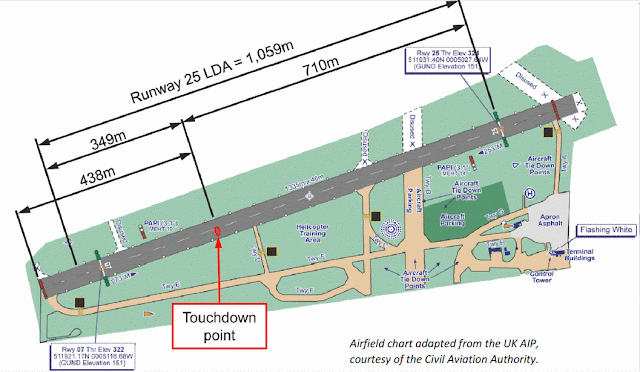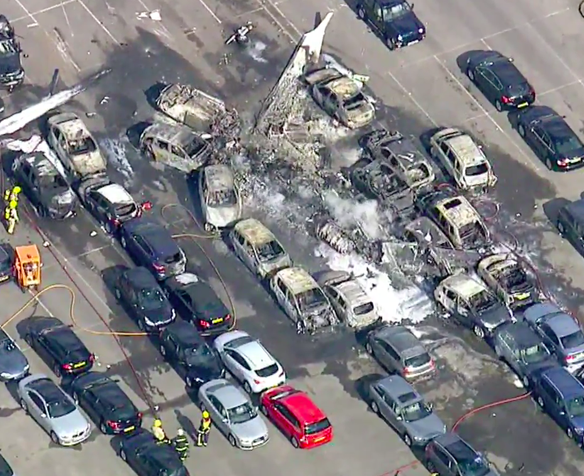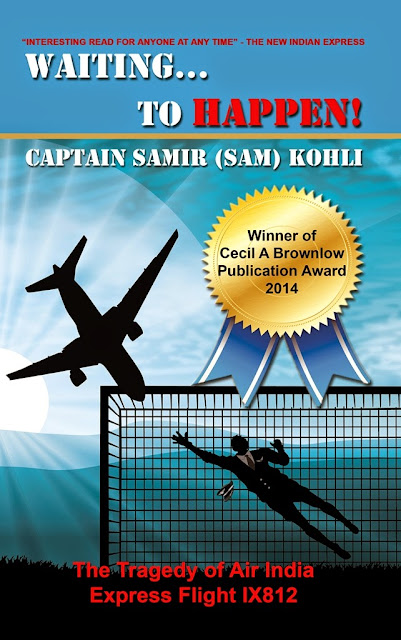HZ-IBN just seconds
before crash (Photo by Geoff Pierce)
In summary, #HZ-IBN,
entered the left-hand circuit for runway 25 at #Blackbushe via the crosswind
leg. Towards the end of the downwind leg, it overtook a micro light aircraft,
before climbing slightly to pass ahead of and above that aircraft. Several TCAS
Resolution Advisories were issued to the pilot during the manoeuvre.
Following
this climb, HZ-IBN then descended at up to 3,000 feet per minute towards the
threshold of runway 25. When HZ-IBN was 1.1 nm from the runway threshold it
flew at 1,200 feet above airfield level at a speed of 146 KIAS, with the
landing gear down and flap 3 selected. The target threshold speed for the
aircraft was calculated to have been 108 KIAS.
The aircraft
continued its approach at approximately 150 KIAS. Between 1,200 and 500 feet
the rate of descent averaged approximately 3,000 fpm. The aircraft’s TAWS
generated six ‘pull up’ warnings on final approach. The aircraft crossed the
threshold of runway 25 at approximately 50 feet at 150 KIAS.
Tyre marks
made by the aircraft at touchdown indicated that it landed approximately 710 m
beyond the runway 25 threshold. Runway 25 has a declared Landing Distance
Available (LDA) of 1,059 m; therefore the aircraft touched down approximately
349 m before the end of the declared LDA, 438 m before the end of the paved
runway surface. The airspeed on touchdown was still 134 KIAS. At this speed the
landing ground roll required to stop the aircraft would be at least 616 m.
The aircraft
departed the paved surface at the end of runway 25 approximately three metres
to the left of the extended runway centreline. It then collided with a one-metre
high earth bank causing the lower section of the nose landing gear and the nose
gear doors to detach. The aircraft became airborne again briefly, before
colliding with several cars parked at an adjacent business and coming to rest
approximately 70 metres beyond the earth bank. The aircraft’s wing detached
from the fuselage during the impact sequence and an intense fire developed
shortly thereafter, consuming the majority of the aircraft. All the four
occupants including the Captain, flying solo, were killed in this accident.
It is clear
from the above discourse that the approach was un-stabilized and should never
have been continued. Yet, it was. The Captain was 57 years old with over 11,000
hrs. of total experience (of which 1,180 hrs. on type), and was personally known
to me. He had participated in many training sessions on SMS and CRM conducted
by me. I had also been involved in development of both, the operations and the
SMS manuals, for the operator as a part of their IS-BAO certification in 2011.
In this sense, I feel deeply affected by this tragedy. He was not a reckless
man. Yet, he seemingly continued an un-stabilized approach and the comment from
his employer, “…Such an experienced Pilot! How could he!” shocks me more than
anything else about this tragedy.
The comment
is a reflection of total lack of understanding of Human Factors in aviation
operations. This in itself gives us a clue on why this accident happened and
how a well-qualified, properly trained and experienced human was forced to err!
This accident is also an almost exact replica of the #IX812 crash I had written
about in my book “Waiting…To Happen!” and has occurred for almost the same
reasons! Un-stabilized approach, very high rate of descent, very high landing
speed, touchdown 2/3rd way up the runway with not enough runway left
to stop the aircraft…the sequence is eerily similar!
Human error
is a symptom, not a disease. It is a start point of an investigation, not its
conclusion. All human performance happens inside an organizations policies and
procedures. It is those policies and procedures that set in motion a “latent
conditions” trajectory, setting in motion a chain of events that culminates
into a human making an error and ultimately an accident. The aircraft was not
being operated in an individual capacity, but under the AOC of a company and
following the policies and procedures as set by the management team. An
accident of this nature is a clear evidence of the management team’s failure to
manage the aircraft and to ensure safe operation of its aviation assets. It is
clear that the Operations and SMS manual contents were not being applied on
ground in their letter and spirit. It is not enough to have a good manual. It
is important to be able to understand that manual and then apply it,
consistently and judiciously, in the company’s daily operations. It is
painfully evident that the company failed it its objective of consistent and judicious
management of safety. The accountability for Safety Management rests with the
Accountable Manager, in this case the Managing Director, and that is where the
questions need to be raised. This is a failure of the Managing Director to
manage safety, and he has a lot to answer for!
Management of
safety does not happen by making statements like “Safety First” and “Safety is
Everyone’s Business”. Safety is NOT everyone’s business. It is the business of
the Accountable Manager, and Accountable Manager alone. By making a statement
like “Safety is Everyone’s Business” the Accountable Manager seeks to escape
his responsibility and creates a situation where somebody should do something, everybody
could do something, but nobody does anything! Instead, the Accountable manager
would do well to lead by example and take the bull by its horns by owning-up
his responsibility, accountability and his failure. Things need to be set right
by acknowledging that “safety first” is wrong notion to perpetuate. No
organization, not even ICAO, was formed totally and only for safety. Every
organization has a primary objective of service delivery. This service must be
delivered safely, but it must first be delivered! This is what needs to be
understood. By making statements like safety first, the management sets in
place a paradox. It creates a false feeling of security where adhoc decisions
are taken in the name of safety. It is important to always remember that Safety
is not accident prevention, but risk management. It is true that management of
risks will prevent accidents, but that will be a corollary to the theorem.
Primary focus needs to remain on management of risks rather than on prevention
of accidents. The end product of the company, in this case the service, must be
delivered safely; otherwise, it is not delivered at all. So, safety needs to
become a way of life…the way we do things around here…identifying hazards and managing
risks before any activity, implementing risk controls, allocating responsibilities,
monitoring implementation of risk controls, collecting and evaluating feedback
and repeating the process again, and again, and again…endlessly.
For this
process to work, it is important that Safety Management is managed at the same
level as other business processes like Financial Management, HR Management,
Marketing Management etc. The most common failure is seen in placing HR,
Financial, marketing etc. in primacy over Safety Management, thereby setting in
place conditions ripe for failure of the Safety process. This often happens
because safety is seen as a non-productive process, an expense item on the
balance sheet. Also, lack of understanding of Human Resources Management by
even some HR professionals results in creation of this paradox. Humans are treated
like objects. They are sought to be managed like objects. Policies and
procedures are not applied across the board or consistently. These conditions
create an environment where the humans see a difference in the written text and
the implementable rules. They are quick to catch the difference and follow what
they “perceive” to be the Managers intent! While their perception may or may
not be correct, they will always do what they perceive is required by their
manager rather than what was meant by the words spoken to them or text written
for them. Moreover, the management keeps wondering, why the humans cannot follow
simple instructions, little realizing that they are actually following the instructions
they perceive rather than what they read or hear!
This is the
real challenge in development of human resources. Human resources cannot be
managed. They can only be developed. They can be developed by providing a
leadership that leads by example. A manager who routinely flies his aircraft
certified to 16,000 ft altitude at 18,000 ft to take advantage of favourable
winds, because he believes that the certification standards were not applied
correctly or one who deliberately mishandles aircraft engines in flight “to
seek the limits of the aircraft” does not set a good example for his employees
to follow. If he applies adhoc methods to manage humans, by displaying lack of
respect, by harassing someone when the person is down and vulnerable, by
applying salary deductions and even withholding salary of an employee based on
his perception that that employee is dishonest, again sets an example that
conveys a message of “anything works here as long as you don’t have an accident”!
Such a manger can never manage safety and will always end with accidents of the
nature of #HZ-IBN.
Management of
safety in Aviation operations is not for the faint hearted. It needs a huge
amount of data to be processed, policies to be administered and processes to be
managed. The only way to achieve this objective is to manage humans humanely,
to be consistent in application of all policies and procedures. The message
that needs to go across is that having an accident/incident is not a crime, but
deviation from a Policy or a Procedure is a crime, always and every time.
#HZ-IBN
crashed because of a Management failure. The failure to manage safety. The
failure to implement the safety risk management process. The failure to
understand human factors in aviation operations. The failure to create workplace
conditions conducive to high-risk environment. The failure to assess workplace
hazards and mitigate the resultant risks. The failure to reinforce defences.
The failure to monitor and deal with errors and violations. In short, a failure
of the Accountable Manager to remain accountable for the operation!
This provided
an opportunity for The Erring Human to strike again, with a tragic loss of four
lives. There is a lot for the owners and managers of the company to contemplate
over. In the tragedy lies an opportunity for change. In this tragedy, there is
an opportunity to rid itself of its sorry legacy and make a course correction,
so that yet another tragedy can be averted. An attitude of self-righteousness
and outrage will not solve any problem. First step in correcting a problem is in
acknowledging that a problem exists and needs to be fixed. Once that step is
taken, the rest will follow naturally and optimistically, a resilient
organization would result.
Stay Safe,
The Erring
Human.





